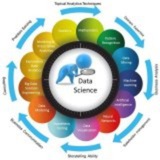Topic: Python Matplotlib – From Easy to Top: Part 6 of 6: 3D Plotting, Animation, and Interactive Visuals
---
### 1. Introduction
Matplotlib supports advanced visualizations including:
• 3D plots using
• Animations with
• Interactive plots using widgets and event handling
---
### 2. Creating 3D Plots
You need to import the 3D toolkit:
---
### 3. 3D Line Plot
---
### 4. 3D Surface Plot
---
### 5. 3D Scatter Plot
---
### 6. Creating Animations
Use
---
### 7. Save Animation as a File
Make sure to install
---
### 8. Adding Interactivity with Widgets
---
### 9. Mouse Interaction with Events
---
### 10. Summary
• 3D plots are ideal for visualizing spatial data and surfaces
• Animations help convey dynamic changes in data
• Widgets and events add interactivity for data exploration
• Mastering these tools enables the creation of interactive dashboards and visual storytelling
---
### Exercise
• Plot a 3D surface of
• Create a slider to change frequency of a sine wave in real-time.
• Animate a circle that rotates along time.
• Build a 3D scatter plot of 3 correlated variables.
---
#Python #Matplotlib #3DPlots #Animations #InteractiveVisuals #DataVisualization
https://t.iss.one/DataScienceM
---
### 1. Introduction
Matplotlib supports advanced visualizations including:
• 3D plots using
mpl_toolkits.mplot3d• Animations with
FuncAnimation• Interactive plots using widgets and event handling
---
### 2. Creating 3D Plots
You need to import the 3D toolkit:
from mpl_toolkits.mplot3d import Axes3D
import matplotlib.pyplot as plt
import numpy as np
---
### 3. 3D Line Plot
fig = plt.figure()
ax = fig.add_subplot(111, projection='3d')
z = np.linspace(0, 15, 100)
x = np.sin(z)
y = np.cos(z)
ax.plot3D(x, y, z, 'purple')
ax.set_title("3D Line Plot")
plt.show()
---
### 4. 3D Surface Plot
fig = plt.figure()
ax = fig.add_subplot(111, projection='3d')
X = np.linspace(-5, 5, 50)
Y = np.linspace(-5, 5, 50)
X, Y = np.meshgrid(X, Y)
Z = np.sin(np.sqrt(X**2 + Y**2))
surf = ax.plot_surface(X, Y, Z, cmap='viridis')
fig.colorbar(surf)
ax.set_title("3D Surface Plot")
plt.show()
---
### 5. 3D Scatter Plot
fig = plt.figure()
ax = fig.add_subplot(111, projection='3d')
x = np.random.rand(100)
y = np.random.rand(100)
z = np.random.rand(100)
ax.scatter(x, y, z, c=z, cmap='plasma')
ax.set_title("3D Scatter Plot")
plt.show()
---
### 6. Creating Animations
Use
FuncAnimation for animated plots.import matplotlib.animation as animation
fig, ax = plt.subplots()
x = np.linspace(0, 2*np.pi, 128)
line, = ax.plot(x, np.sin(x))
def update(frame):
line.set_ydata(np.sin(x + frame / 10))
return line,
ani = animation.FuncAnimation(fig, update, frames=100, interval=50)
plt.title("Sine Wave Animation")
plt.show()
---
### 7. Save Animation as a File
ani.save("sine_wave.gif", writer='pillow')Make sure to install
pillow using:pip install pillow
---
### 8. Adding Interactivity with Widgets
import matplotlib.widgets as widgets
fig, ax = plt.subplots()
plt.subplots_adjust(left=0.1, bottom=0.25)
x = np.linspace(0, 2*np.pi, 100)
freq = 1
line, = ax.plot(x, np.sin(freq * x))
ax_slider = plt.axes([0.25, 0.1, 0.65, 0.03])
slider = widgets.Slider(ax_slider, 'Frequency', 0.1, 5.0, valinit=freq)
def update(val):
line.set_ydata(np.sin(slider.val * x))
fig.canvas.draw_idle()
slider.on_changed(update)
plt.title("Interactive Sine Wave")
plt.show()
---
### 9. Mouse Interaction with Events
def onclick(event):
print(f'You clicked at x={event.xdata:.2f}, y={event.ydata:.2f}')
fig, ax = plt.subplots()
ax.plot([1, 2, 3], [4, 5, 6])
fig.canvas.mpl_connect('button_press_event', onclick)
plt.title("Click to Print Coordinates")
plt.show()
---
### 10. Summary
• 3D plots are ideal for visualizing spatial data and surfaces
• Animations help convey dynamic changes in data
• Widgets and events add interactivity for data exploration
• Mastering these tools enables the creation of interactive dashboards and visual storytelling
---
### Exercise
• Plot a 3D surface of
z = cos(sqrt(x² + y²)).• Create a slider to change frequency of a sine wave in real-time.
• Animate a circle that rotates along time.
• Build a 3D scatter plot of 3 correlated variables.
---
#Python #Matplotlib #3DPlots #Animations #InteractiveVisuals #DataVisualization
https://t.iss.one/DataScienceM
❤3
